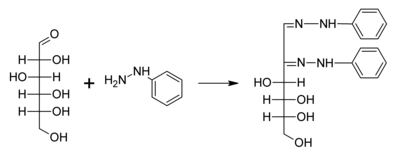Osazone

Osazone are a class of carbohydrate derivatives found in organic chemistry formed when reducing sugars are reacted with excess of phenylhydrazine at boiling temperatures.[1][2]
Formation
Osazone formation was developed by Emil Fischer,[3] who used the reaction as a test to identify monosaccharides.
The formation of a pair of hydrazone functionalities involves both oxidation and condensation reactions.[4] Since the reaction requires a free carbonyl group, only "reducing sugars" participate. Sucrose, which is nonreducing, does not form an osazone.

A typical reaction showing the formation of an osazone. D-glucose reacts with phenylhydrazine to give glucosazone. The same product is obtained from fructose and mannose.
Appearance
Osazones are highly coloured and crystalline compounds. Osazones are readily distinguished.[5]
- Maltosazone (from maltose) forms petal-shaped crystals.
- Lactosazone (from lactose) forms powder puff-shaped crystals.
- Galactosazone (from galactose) forms rhombic-plate shaped crystals.
- Glucosazone (from glucose, fructose or mannose) forms broomstick or needle-shaped crystals.
Historic references
- Fischer, Emil (1908). "Schmelzpunkt des Phenylhydrazins und einiger Osazone". Berichte der Deutschen Chemischen Gesellschaft. 41: 73–77. .
- Fischer, Emil (1894). "Ueber einige Osazone und Hydrazone der Zuckergruppe". Berichte der Deutschen Chemischen Gesellschaft. 27 (2): 2486–2492. .
- Barry, VINCENT C.; Mitchell, PW (1955). "Mechanism of Osazone Formation". Nature. 175 (4448): 220. PMID 13235861.
References
- ISBN 9780120072552. Retrieved 31 March 2021.
- .
- .
- ISBN 9788125020714.
- ISBN 978-981-13-1035-5.


